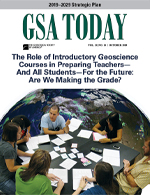Full Text View
Volume 29 Issue 10 (October 2019)
GSA Today
Article, pp. 4-10 | Full Text | PDF (1.5MB)
The Role of Introductory Geoscience Courses in Preparing Teachers—And All Students—For the Future: Are We Making the Grade?
Abstract
Introductory geoscience courses enroll hundreds of thousands of students a year, most of whom do not major in the geosciences. For many, including future K–12 teachers, an introductory course is the only place they will encounter Earth science at the college level. New standards for K–12 science education have profound implications for teacher preparation, particularly in Earth science. The new standards call for taking a systems approach, highlighting how humans interact with Earth, making use of science and engineering practices, and engaging students in discourse. Analysis of responses to the National Geoscience Faculty Survey (n = 813 in 2004; n = 994 in 2009; n = 972 in 2012; and n = 1074 in 2016) and data from 152 syllabi suggest that a systems approach is not widespread and human interactions with Earth are not emphasized, and that most instructors engage students in mostly low cognitive-level practices. While the use of discourse practices has increased over time, these and other active learning components are not yet widely included in students’ grades. These results suggest that courses are not currently well-aligned with teacher needs. However, instructors have access to many research-based instructional resources to support them in making changes that will help all students—including future teachers.
Manuscript received 25 Oct. 2018. Revised manuscript received 3 Apr. 2019. Manuscript accepted 12 Apr. 2019. Posted 10 May 2019.
© The Geological Society of America, 2019. CC-BY-NC.

